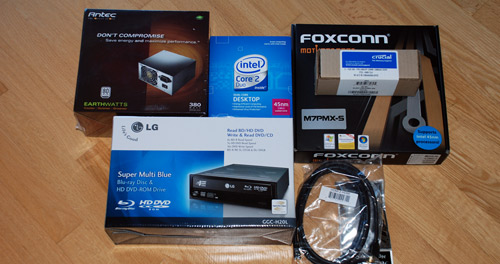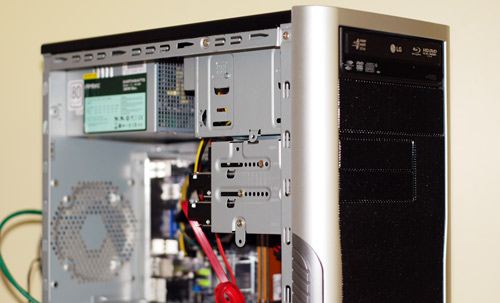In the first part of this Going HD series I discussed the arrival of a 50-inch Samsung plasma HDTV as the core of my new HD setup. I've spent almost two weeks with the HDTV and I have no complaints thus far; it's a stellar display. The only problem has been getting 1080p HD content on the display to really use it. I have DirecTV satellite service from my building, along with the HD package and HBO, but surprisingly only a few channels are in HD. One of those reasons has to do with my building only having a 3 LNB satellite at the moment, although an upgrade to 5 LNB is coming, so it can't access content on two of the newer satellites that offer most of the HD programming.
Even with HDTV channels, the quality could be better. If you want true HD you'll have to get it from a direct no-compromise source like a Blu-ray player or a large movie file from your computer. What I had to do became apparent: beef up my media server so that it could tackle HD content without a problem.
HTPC Setup
My media server has been the "DIY 200 PC" I wrote about in earlier this year (Part 1, Part 2, Part 3). It had very low specs: 1GHz CPU and shoddy SiS962 graphics. Needless to say, it was far from capable of playing HD videos. However, with a 750GB storage drive and a 10k RPM 74GB OS drive, it was great at downloading and serving files on the network. After a bit of research, I ended up ordering these parts from Newegg to revamp the media server:
- Foxconn M7PMX-S Motherboard with Nvidia GeForce 7100 integrated graphics, nForce 630i chipset and HDMI out ($60 not incl rebate)
- Intel Core 2 Duo 2.53GHz processor, Wolfdale 45nm ($132)
- 2GB (2 x 1GB) Crucial Ballstix DDR2-800 ($55 not incl rebate)
- Antec EarthWatts 380W PSU ($35)
- LG Blu-ray/HD-DVD reader & DVD writer ($160)
- Coolermaster Elite 340 case (purchased from Fry's for $35)
- Western Digital 74GB Raptor hard drive (already had it)
- 2 x Seagate 750GB hard drive (already had one, $109 for the other)
45nm Praise
For a computer that's going to play high definition content most of the time and decompress large downloads the rest of the time, choosing a sufficiently beefy processor is important. While pretty much any Core 2 Duo over 2GHz can handle this task without issue, I made it a point to select a 45nm processor. The cheapest 45nm Wolfdale CPU was the 2.53GHz Core 2 Duo for 132.
So what are the benefits of a 45nm processor over the more common 65nm processors? They use less power in general and as a result create less heat; both are ideal for a computer that will be on 24/7. What I didn't know was how much cooler these chips run in real life though. After giving the HTPC a few tasks to fully-utilize the CPU, the heatsink was still cool to the touch, the fan wasn't expelling hot air or anything. The stock Intel HSF is fairly slim too so there's no heatsink magic happening here.
If you plan on upgrading to a 45nm CPU, make sure your motherboard supports it. Just because it has an LGA 775 socket doesn't mean it will work right out of the box. Most likely a small firmware update will be necessary if your motherboard is a bit old. I chose the Foxconn M7PMX-S motherboard because it was cheap, supported 45nm CPUs and had on-board Nvidia graphics with an HDMI output.
Blu-ray!
What's a high definition HTPC without a Blu-ray player? I picked up one of the cheapest Blu-ray drives I could find: the LG GGC-H20L. It's a SATA drive that can play Blu-ray discs as well as HD-DVDs in addition to being able to burn DVDs.
Blu-ray is tricky.
After I setup a test rig on my desk I immediately installed Ubuntu 8.04. I'm very comfortable working with Ubuntu and it has worked well on my media server. Installation went by smoothly and only took 15 minutes. I installed the Nvidia nForce/GeForce driver and that worked perfectly. I was able to run full resolution and even enable Compiz features. Sound worked as well too.
After the initial configuration was complete I began playing a 1080p video file to ensure the system had enough horsepower to avoid dropping frames. Indeed it was more than powerful enough. However, I did note that VLC player used a bit more CPU resources than M Player did, at least with the MKV file I was playing.
Then I spent at least 6 hours trying to play a Blu-ray movie in Ubuntu. I was not successful this time. I won't go into details, particularly since playing Blu-ray movies in Linux consists of bypassing DRM and is considered illegal in the United States, but it consists of compiling the kernel to support UDF 2.5, grabbing the AACS key from a Blu-ray disc and getting an application to rip and decrypt the data. It is "possible" to play the Blu-ray without ripping but requires an advanced setup and enough system resources to be able to decrypt on-the-fly. Then there is the issue of when the disc was produced and if that encryption key hasn't already been found and put into a database, it is necessary to use a tool to find the Volume ID manually and other such cumbersome tasks. I may revisit this later on but at the moment it's just not worth messing with Blu-ray in Linux.
I was quite vexed that I couldn't get Blu-ray working in Ubuntu, but I figured it would work without a problem in Vista.

FAIL. The Blu-ray player software included with the drive requires that everything supports HDCP. The only thing that doesn't support HDCP in my setup is the built-in GeForce 7100 graphics. That means I'll have to get a higher-end video card later on to get that working.. or give DRM-bypassing another go.
To be continued..
I still have to work out networking issues. I had a nice Samba share configured in Ubuntu and could easily SSH in to do whatever I needed, making it easy to work without a display. With Vista, I'll probably have to keep it tethered to a display and snake an HDMI cable around the wall to the HDTV for playing media.
Thoughts? What kind of stuff is in your HTPC, what software do you use and how do you use it?



